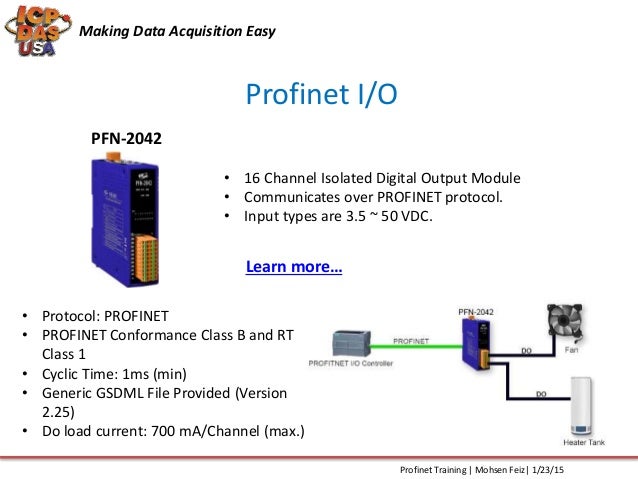
GSDML are GSD files written in XML format. They describe the features of the PROFINET device model. GSDML editing can be accomplished with standard XML editors and should comply with ISO 15745, the base for device descriptions. The aim is to allow better integration of devices into an engineering tool. PROFINET IO GSDML Data V2.3 with PROFINET Standard Diagnosis Support for CI501-PNIO (-XC) and CI502-PNIO (-XC) communication interface modules - AC500 PLC and AC500-S Safety PLC - Electronic Device Description files - Release date.
PROFINET Competence Center FAQ
Supermicro visio stencils download. Q1: What is PROFINET?
PROFINET is the Industrial Ethernet solution from PI (PROFIBUS & PROFINET International). PI is a multi vendor organization, responsible for developing and promoting the PROFIBUS & PROFINET technologies. PROFINET allows to exchange IO-Data over Ethernet in real time. PROFINET RT (Real Time) is using standard Ethernet (IEEE 802.1) hardware, while PROFINET IRT (Isochronous Real Time) is using specific hardware to provide accurate jitter(<1μS). Both PROFINET RT and IRT allow to transport simultaneously Real time IO-Data and common data using IT protocols (HTTP/SNMP)
Molex is an active member of PI, involved in the PROFINET specification process. Reward business resource pack pdf vk. The current specification is version V2.3.
Q2: What is the Vendor Identifier? How to get it? What is the DeviceID?
A vendor identifier (VendorId) is used to identify the manufacturer of a PROFINET node. This 16 bits identifier is uniquely identifying PROFINET manufacturers, and it provided by PI. Manufacturers shall request it to PI sending a mail to info@profibus.com. A PROFINET node provides its VendorId & deviceId over the network. The DeviceId is also a 16 bits identifier, uniquely identifying the device from the manufacturer offering. DeviceId is managed by the manufacturer. VendorID & DeviceID are used in the GSD file.
Q3: What is the GSDML file?
The GSDML file is the IO-Device description file. The description file is formally called GSD file, and GSDML indicates it is a description file for a PROFINET IO-Device, based on XML language. The current version of the GSDML specification is V2.25. The GSDML file is used by the engineering tool to configure the PROFINET connection parameters. It is necessary (and mandatory) for an IO-Device manufacturer to provide the associated GSDML file.
Q4: What about the certification process?
In order to guaranty the interoperability of PROFINET nodes, PI, as a quality procedure, set the certification as mandatory for the IO-Device. To get a certificate, the IO-device manufacturer shall succeed running the certification tests. These tests have to be made per a PI certified test laboratory, where procedures, independence and expertise have been audited. There are test labs available all around the world. Based on the test report, PI is going to issue the certificate.
Q5: Should an IO-device integrate an additional LED for PROFINET?
Basically, PROFINET provides the ability to distinguish an IO-Device in between others by blinking a led. From a standardization point of view, it is not mandatory to use a dedicated LED. Other signaling system could be used, as well as the LINK led. The PROFINET specification defines the frequency and the duration.
Q6: What kind of characters could be used into PROFINET station name?
PROFINET station name should comply with RFC3490. Basically, only lower case characters 'a' to 'z', '0' to '9' and '-'are usable. Character '.' is used to separate label, that is a group of maximum 64 characters. PROFINET station name could be as long as 240 characters and shall be uniquely assigned. The station name is used to detect PROFINET nodes.
Q7: How IP addresses are distributed in a PROFINET System?
Different possibilities exist. DHCP & DNS could be used, as well as static address assignment. Nevertheless, PROFINET basically provides its own protocol (DCP) allowing IP addresses distribution, without additional tool than the engineering tool (All in one management). A PROFINET IO-Controller has the ability to set the IP address of an IO-Device during connection establishment. Duplication of IP address is de facto managed.
Q8: What is the meaning for PROFINET RTClass1 and RTClass3?
PROFINET RTClasses are used define precisely the type of the Real time data exchange being used by a PROFINET Connection. PROFINET RTClass1 is related to PROFINET RT communication based on standard Ethernet hardware. Cycle time of 1mS could be achieved with PROFINET RTClass1, but jitter is not controlled. PROFINET RTClass3 is related to PROFINET RT communication based on dedicated Ethernet interface, using synchronization over all nodes of the PROFINET network (including switches). Cycle time of 250μS could be achieved with jitter less than 1 μS is guaranteed. PROFINET RTClass3 is now available with built-in optimization called IRT+.
Q9: Where should be connected the shielding of the cable on a PROFINET system?
Cable and connectors to be used in PROFINET system are specified, and certified items have to be used. In PROFINET system, shielded cables shall be used. The specified connectors allow to connect the cable shield to the internal electronic. The shielding has to be coupled to the system earth.
Q10: Could I use a hub inside a PROFINET network? What kind of switch shall be used?
Usage of hub is prohibited. PROFINET is specified to run on Ethernet with at least the following standard characteristics: 100Mb, Full duplex, Auto-Negotiation, Auto-Sensing and Auto-polarity. All those characteristics are basically Ethernet (802.1x), and supported by most of the Ethernet chipsets. PROFINET is 100% Ethernet compatible, unless requirements are not covered by 802.1x (eg: high performance real time communication)
Please if you have technical question, send request to our experts